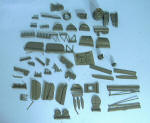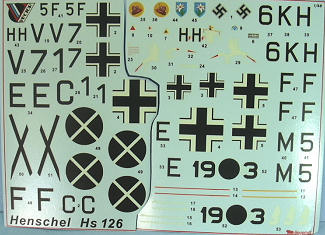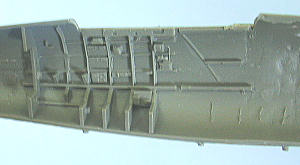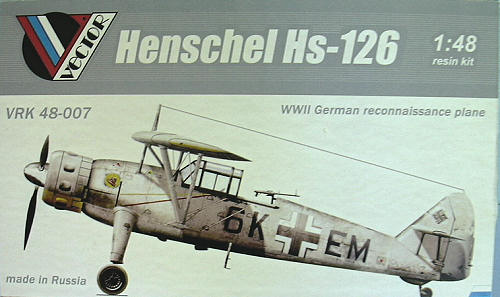Vector 1/48 Hs-126A-1
“Corps reconnaissance” was developed during the First World War.
Dedicated front line reconnaissance aircraft continued to be designed and
produced afterwards, with some of the more famous being the British
Westland
Lysander and the German Henschel Hs-126A-1.
Within two years of the outbreak of the Second World War, these aircraft
had left frontline service, having been found unable to survive in the frontline
aerial environment.
The Henschel Hs-126A-1 was the penultimate development of a line of
German two seaters that included the Heinkel He-45 and He-46, along with the
Henschel Hs-122. The Hs-126A-1
offered higher performance than these types and was all metal in construction,
with fabric-covered control surfaces.
The aircraft was developed from the earlier Hs 122 design of 1935, but
offered improved performance and handling characteristics.
The Hs 126 was well received, due to its good
short takeoff and low-speed characteristics.
By the outbreak of the Second World War, the Hs-126A-1 equipped the
majority of the Luftwaffe's field reconnaissance units.
While it was outstandingly successful in the Polish campaign, it was
found to be very vulnerable to opposing fighters during the campaign in the West
in 1940, capable of operating only under conditions of air superiority.
The Hs-126A-1 went on to serve in the Balkans campaign and on the Eastern
Front, with one Staffel equipping the Afrika Korps in 1941.
By 1942, the Hs-126A-1 was outperformed by the Fieseler Storch, which had
even greater STOL capability as well as better low-speed handling.
The Fw-189 had the performance to survive in the frontline reconnaissance
role on the Eastern Front, and the Hs-126A-1 was rapidly replaced in frontline
units. By 1943 it was relegated to
the roles of squadron hack, trainer, and glider tug.
 If you've ever seen a Vector resin engin
If you've ever seen a Vector resin engin e, you know the quality of resin
casting that this kit presents.
Vector's Lavochkin series has generally been considered as the best kits of
those aircraft available in 1/48 scale and well worth their price.
e, you know the quality of resin
casting that this kit presents.
Vector's Lavochkin series has generally been considered as the best kits of
those aircraft available in 1/48 scale and well worth their price.
This kit is the seventh full-resin kit from Vector, and it sets an even
higher standard than was found in the previous kits.
At first look, one could easily mistake the dark olive resin for styrene
plastic, providing smooth surfaces and crisp, subtle details.
The molded-in cockpit interior is much superior to what any
injection-molded kit would provide.
The rest of the detail is
 of equal quality.
The seats have harness detail molded in that looks very realistic.
of equal quality.
The seats have harness detail molded in that looks very realistic.
 Vector's reputation rests on engines, and this model of the BMW 132 is a
model in its own right. Control
surfaces are all separate, with blade-sharp trailing edges.
The landing gear can be done with or without the spats.
Additional side armor is provided for the Eastern Front options.
Vector's reputation rests on engines, and this model of the BMW 132 is a
model in its own right. Control
surfaces are all separate, with blade-sharp trailing edges.
The landing gear can be done with or without the spats.
Additional side armor is provided for the Eastern Front options.
Decals are provided for six aircraft, one from the Condor Legion in
Spain; one from the Polish campaign; one from the Finnish front; two from the
Eastern Front, including one in winter camouflage; and one from the North
African campaign.
This is one of the best all-resin kits it has been my privilege to see.
I can't recommend this to a first-time resin kit builder, due to the
extreme fragility of the bracing struts for the wing, where the successful
outcome is going to depend on “some advanced modeling skill required.”
However, if you've done a couple resin kits, you'll love this one.
As a kit it is far superior to the only other 1/48 Hs-126 out there,
which was done by Fonderies Miniatures.
It is well worth its price, and will turn into a beautiful model when
completed.
Review kit courtesy of Vector.
Tom Cleaver
May 2009
If you would like your product reviewed fairly and quickly, please
contact
me or see other details in the
Note to
Contributors.
Back to the Main Page
Back to the Previews Index Page


 If you've ever seen a Vector resin engin
If you've ever seen a Vector resin engin e, you know the quality of resin
casting that this kit presents.
Vector's Lavochkin series has generally been considered as the best kits of
those aircraft available in 1/48 scale and well worth their price.
e, you know the quality of resin
casting that this kit presents.
Vector's Lavochkin series has generally been considered as the best kits of
those aircraft available in 1/48 scale and well worth their price. of equal quality.
The seats have harness detail molded in that looks very realistic.
of equal quality.
The seats have harness detail molded in that looks very realistic.
 Vector's reputation rests on engines, and this model of the BMW 132 is a
model in its own right. Control
surfaces are all separate, with blade-sharp trailing edges.
The landing gear can be done with or without the spats.
Additional side armor is provided for the Eastern Front options.
Vector's reputation rests on engines, and this model of the BMW 132 is a
model in its own right. Control
surfaces are all separate, with blade-sharp trailing edges.
The landing gear can be done with or without the spats.
Additional side armor is provided for the Eastern Front options.